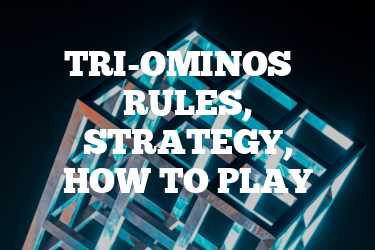Tri-Ominos: A Guide to Strategy, Rules, Instructions and Winning
Introduction
Tri-Ominos is a game in the dominoes family but with a twist. Instead of rectangular tiles, you have triangular ones. Each tile has three numbers, one on each corner. The game was invented back in the 1960s and has been a family favorite for years, including in our household where it can get quite competitive, even when the game is easy to learn.

The goal is to score points by matching tiles and creating certain configurations on the table. It’s a mix of luck and strategy, and you can play it with two to six people.
I’ve written a few guides about other dominoe-style games before, including Kingdomino, but I do recommend checking out Tri-Ominos for it’s lesser-known qualities.
Quick Tip for Tri-Ominos
Always keep a variety of numbers in your hand to increase your chances of being able to play a tile on your turn.
Rules for playing Tri-Ominos
Understanding the rules of Tri-Ominos is key to enjoying the game. Each player starts with a set number of tiles, and the rest are left face down as a draw pile. You start the game by playing a tile, and then players take turns adding matching tiles to the table. You can only play a tile if it has two numbers that match two numbers on the tiles already played. If you can’t play, you draw a tile from the pile. You get points for each tile you play, and bonus points for special moves like creating a bridge or a hexagon. The game ends when someone plays all their tiles or no more moves are possible. Then, you tally up the points, and the person with the highest score wins.
Equipment and Setup for Tri-Ominos
To play Tri-Ominos, you need a set of Tri-Ominos tiles. Each set usually has 56 triangular tiles with numbers from 0 to 5 on the corners. To set up, shuffle the tiles face down and give each player their starting hand.
The number of tiles each player starts with depends on how many people are playing. If you don’t have a Tri-Ominos set, you could make a DIY version with cardboard triangles and a marker, but it’s a lot of work.
How to Play Tri-Ominos and Game Mechanics
The game mechanics of Tri-Ominos are simple once you get the hang of it. Here’s how you play:
- Setup: Shuffle the tiles and deal the starting hand. The rest form the draw pile.
- Gameplay: Players take turns adding tiles to the table, matching numbers on the edges.
- End of the Game: The game ends when a player clears their hand or no more moves can be made.
During gameplay, you can take actions like playing a tile, drawing from the pile, or passing if you can’t play even after drawing.
How to Win at Tri-Ominos
Winning at Tri-Ominos involves a mix of strategy and luck. Beginners should focus on playing their tiles and scoring points. Intermediate players can start looking for opportunities to score bonus points. Advanced players will think several moves ahead, trying to predict what tiles their opponents have and playing to block them while setting up for big scoring moves themselves.
Best Strategies for playing Tri-Ominos game
To excel at Tri-Ominos, I find that strategic play is crucial. One of the best strategies is to start by playing your heaviest pieces early on, as this can score you the most points while also decreasing the risk of being stuck with high-point tiles if the game ends abruptly.
It’s also important to pay attention to the board layout and plan your moves to open up new opportunities for placement while simultaneously trying to block your opponents. Always keep a variety of numbers in your hand to maintain flexibility in gameplay.
Additionally, try to control the center of the board; this can give you more options for tile placement and can limit your opponents’ plays. Keeping track of which numbers have been played and anticipating what your opponents hold can give you a tactical edge.
By combining these strategies with quick thinking and adaptability, you can increase your chances of success in Tri-Ominos.
Scenarios
Good scenarios in Tri-Ominos are when you can play multiple tiles in one turn or score a big bonus. Bad scenarios are when you’re stuck with high-numbered tiles that are hard to match. To turn these around, try to change the shape of the play area by adding tiles that open up more opportunities for matching.
Frequently Asked Questions about playing Tri-Ominos game
- Q: What if I can’t play a tile?
A: If you can’t play, you draw one tile from the pile. If you still can’t play, you pass your turn. - Q: How many points is a bridge worth?
A: A bridge, which is when you complete a hexagon, scores you 40 bonus points. - Q: Can I play out of turn?
A: No, you must wait for your turn to play a tile. - Q: What happens if the draw pile runs out?
A: If the draw pile runs out, you continue playing with the tiles in hand until someone goes out or no more moves can be made. - Q: How do you start the game?
A: The player with the highest triple-numbered tile starts the game by playing it.
Additional Subtopics
Other things to consider when playing Tri-Ominos include managing your hand effectively and being aware of the tiles that have been played. It’s also good to think about the pace of the game. Sometimes it’s better to play slowly and strategically, while other times you might want to play quickly to put pressure on your opponents.
External Links
For more information on Tri-Ominos, check out the official rules and other resources:

A digital native around since the early days of online gaming communities around 2001. An early contributor to the cult gaming site ClanTemplates, Adam has spent years giving free gaming resources to the community. With BoardCards, Adam is most experienced and commonly writing the articles on Strategy multi-player games like Settlers of Catan and Avalon. His first introduction to board games was via Mancala, an Egyptian-origin stone game and one of the oldest known games still played worldwide. Contact me via email



